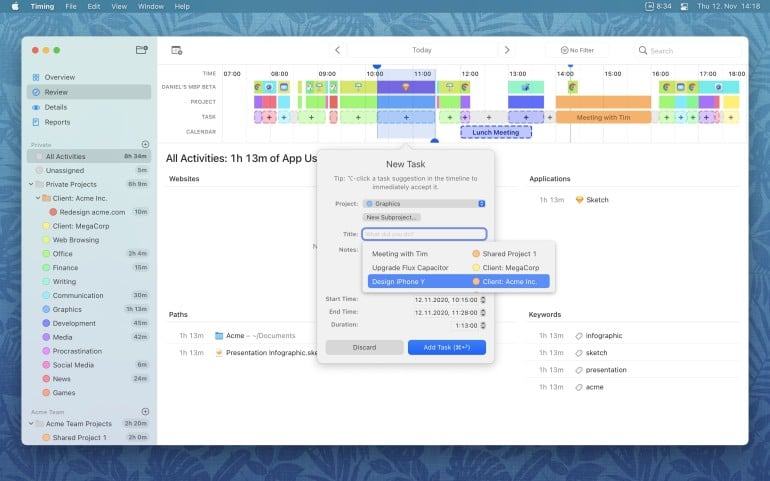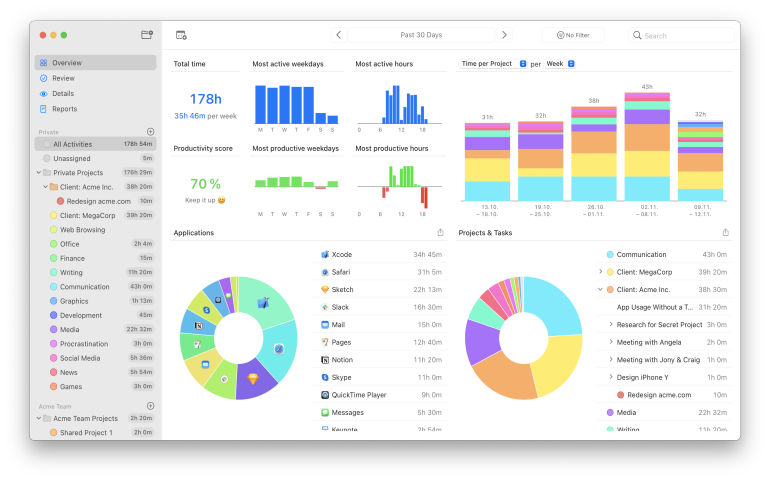How to Improve Project Management with Time Tracking Software
![]()
Whether you work for yourself or someone else, the benefits of project management are undeniable. It keeps you organized, helps you manage deadlines, and ensures you meet all of your obligations. Without project management, there’s a good chance tasks will fall through the cracks, which will ultimately disappoint your clients and affect your revenue.
According to the consultancy firm Bain & Company, most work will be project-based by 2027. This explains why the demand for project managers has been growing faster than the demand for skilled workers in other occupations. Putting someone in place to manage the project is often more effective and more productive than adding another person to handle the frontline work.
While 77% of high-performing projects use some kind of project management software, many people don’t take project management seriously. According to Project Management Institute, only 23% of people use standardized project management practices. These people are leaving productivity on the table (and probably losing revenue).
Now, if you work for yourself, you have to be your own project manager. But that doesn’t mean the role is any less important. The impact of good project management is too big to ignore, but only if you think strategically and objectively about your work performance.
Time tracking is a key way to enhance the effectiveness of your project management. It provides you with the information you need to plan your schedule, make good decisions, analyze your performance, and bill your clients appropriately. This is why time tracking is one of the most-used features in project management tools.
In this article, we’re going to offer some key tips to improve your project management with the help of time tracking software. These are not one-off techniques. They are long-term habits you should build into your workflow to keep yourself organized, efficient, and productive.
If you’re currently using a project management tool that doesn’t include a time tracking feature, don’t worry. We’re going to explain why Timing, an automatic time tracking app for Mac, offers superior features to the simple time counters in most project management apps. (Download a free trial of Timing here.)
Time tracking is a key way to enhance the effectiveness of your project management. Share on XTips for Improving Project Management
Time-tracking is only effective when you make it part of your overall strategy. It should be a method of optimization, not just another task that eats up your time and creates a net negative effect on your productivity. Here are some tips to improve your project management efforts with time tracking software.
1. Actually use special time tracking software
![]()
The first rule is the most important. Tracking your time is a key way to improve your project management work. But not just any tool. You need the right tool that suits your needs and the needs of your and your team, with plenty of features that facilitate quality work and eliminate trivial tasks.
Furthermore, you have to actually use the tool. We hear about people who understand the value of time tracking software, but they fail to use it regularly (among other mistakes). They forget to turn it on and decide there’s no need to track “this one little task.” Like all tools, time tracking software only works if you use it.
(Quick aside: It’s worth pointing out that time tracking apps have benefits beyond your work schedule. You can track non-work time as well, such as family time, social time, exercise, relaxation time, or sleep.)
2. Help your team adopt your time tracking app
If you have a team, you’ll also need to take steps to get them to use the time tracking app. Since the time tracking data isn’t for them, team members often forget to turn on the app when they start work. Some don’t understand what activities should be tracked and how to use their tracking apps. You’ll have to spend some educating them on how to use the tool.
Sadly, some people actively avoid time tracking software. They worry their employers will use it to squeeze every ounce of work out of them or to write them up for going on Facebook. If you have team members like this, you’ll have to explain to them how you use the data and why they shouldn’t feel threatened.
The best solution is to have your team use an automatic time tracking app like Timing. They won’t need to start or stop the timer. Nor do they need to categorize their activities per client or project. Timing takes care of all of that. (Though you may need to instruct them on how you like clients, projects, and tasks organized.
3. Learn more about your distractions

We all get distracted at some point during the day. Maybe we check Facebook real quick, read an irresistible news article, or watch the YouTube video your friend shared. Little distractions are fine, but too many can eat up precious time and extend our projects.
By documenting everything you do on your computer, time tracking software gives you a comprehensive view of your time. This allows you to see how much time you spend on distracting activities. You can use this information to optimize your time management. For instance, if you spend too much time on Facebook, you might decide to block Facebook from your browser during work hours.
Additionally, time tracking software can make you aware of distractions and overages that you didn’t realize were a problem, even if they are related to work. For instance, if you scheduled 90 minutes worth of Zoom meetings in a week, but actually spent 110 minutes in Zoom, you’re losing time and money.
4. Identify the most profitable clients

You love all of your clients, but you know that certain clients are more profitable than others. Perhaps the work is especially easy for you. Perhaps you have a special tool, script, or outsourcer that works quickly. Perhaps one client represents a significant portion of your income. It’s important to understand each client’s profitability as well as what makes that account profitable. This will help you protect that relationship.
For instance, let’s say you have a client who pays you $500 to make logos. Each logo typically requires five hours of work. Instead of designing the logo yourself, you contract the job to a friend for $450. You only make $50, but the time investment is almost zero: just a few minutes to assign the task to your friend and send it to the client. When you consider time versus return, that’s actually your most profitable client.
Time tracking software can help you uncover these critical insights. Perhaps instead of offering design services, you’re really a design broker. A realization like that would have a profound effect on your business (and hopefully your income), but you can only see it if you have data-backed evidence to review your performance.
5. Organize your time tracking by project
Whether you work for yourself or are employed by a company, you probably use the same applications regularly across many different projects. For example, if you are a graphic designer, you spend a lot of time in Photoshop and Illustrator for all of your clients. At the end of the week, you may know how much time you spent using a particular application, but you don’t know how it breaks down across all of your clients.
The right time tracking software can solve this problem for you. The best time tracking apps (including Timing) allow you to sort your work into projects. You can organize those projects however you like. Furthermore, it helps to have the functionality to group tasks and projects with clients so you know exactly how you spent your time.
In Timing, you can create clients, projects, and subprojects. You can do this manually or create your own rules for Timing to automatically sort your tasks. You can even share clients and projects with other people on your team, freelancers, or vendors to get a comprehensive view of your activities.

6. Provide clients with more accurate timesheets
If your clients require you to send them timesheets in order to track your projects, you know how difficult these can be to prepare. For one, preparing the actual document takes time that you don’t get paid for (or have to raise your rates to allow). For another, it’s impossible to be accurate unless you’re using a tool to track the time. If you try to guess how much time you spent, you’ll either short yourself or overcharge the client.
Time tracking software makes your life easier here, especially if you use a tool like Timing that records your activities automatically. You don’t need to document anything as you work. The software takes care of all of it for you. At the end of the project, you have a 100% accurate log of how you spent your time.
Furthermore, time tracking software can generate reports for you. There’s no need to do anything to produce a timesheet. All it takes is a click of a button to produce the right report for your client. You’ll appreciate one less trivial task to clutter your work day. Your clients will appreciate not having to pay you to perform simple tasks.
To learn how to create reports at the task or project level, check out our full guide: How to Create a Project- or Task-Specific Report in Timing.
7. Create better project estimations
You’ve undoubtedly been in this situation before: You wrap up a project only to realize you spent far more time on it than originally expected. Now the quote you gave the client doesn’t make sense. You could either a) explain to the client why the bill is significantly higher, or b) take the loss and try to do better next time. Neither solution is optimal.
With time tracking software, you can look back at old projects to understand their real time costs. You can use what you learn to create better time estimates for upcoming projects. You might say, “Oh, I did a project just like this three months ago. Let me see how long that took.”
For instance, let’s say a client wants you to build a 10-page WordPress website with a custom theme. You can browse your data to learn how long it took to build a similar website for a past client. Obviously you’ll have to make some slight tweaks based on the upcoming project’s needs, but these lookbacks can get you close. Ultimately, this creates a more accurate estimate, which ensures the client is satisfied with your service and you get paid appropriately.
8. Avoid overworking your team
If you run a team of employees or work with contractors, you may have inadvertently overworked them at one point in the past. Perhaps you put more on their plate than you expected or didn’t realize the true time cost of one of their assignments. With the information provided by time tracking software, you can avoid this problem in a few ways.
- You can give better estimates to clients (like we explained above)
- You can keep them working at a comfortable pace without burning them out.
- You can ensure everyone’s workload is fair and in accordance with their contracts.
- You can make sure you’re bringing in enough revenue to pay them.
9. Set realistic due dates and deadlines

Whether you establish contractual deadlines for clients or set personal deadlines, keep those timelines reasonable and achievable. If your deadlines are too short, you’ll often fail to meet them, which displeases your clients and disrupts the rest of your work. If your deadlines are too far out, you’ll expect projects to take longer than they actually will, which might add unpaid gaps in your schedule.
The data from your time tracking software can help you estimate how long a particular project will take. Look back at similar projects to learn how long they took and consider whether those timelines were appropriate. Use that information to set realistic due dates in the future.
Furthermore, if your clients protest the deadlines you set, you can always use your time tracking data to support them. You could respond, “Here’s my time tracking for a similar project. I expect your project to take about the same.” This will reassure your clients that you aren’t taking advantage of them.
10. Prioritize important or time-sensitive tasks
When you work on a project, some tasks are more urgent than others. Some tasks are nice-to-finish, but only if there’s time at the end. Other tasks have to be completed in a certain order or by specific deadlines.
Naturally, you want to complete tasks in the right order to ensure the project moves along smoothly. Time tracking software helps you make sure the tasks you’re working on actually matter. You can quickly look back through your activity to see if what you worked on matches what you were supposed to work on.
This is another important way to improve the performance of your team. By regularly reviewing their time, you can make sure they’re spending it on the right tasks. If they get off course, you can redirect them to more important tasks before it becomes a real problem that affects your project.
11. Analyze your performance
Are you working at a reasonable pace? Are you completing tasks on time and efficiently? Are you allowing yourself to succumb to pointless distractions? Do your quotes and estimates match your time logs? Are you spending the same amount on similar tasks, or are some taking longer than others?
These (and others) are important questions you should ask yourself regularly about your projects. Your time tracking data will help you see the big picture, understand your productivity dynamics, and help you identify what you’re doing right and what needs to be optimized.
Furthermore, time tracking software will help you identify hidden costs and unexpected delays. For instance, you may not think to factor the time it takes to read and respond to emails in your project quotes, but after checking your time data, you might realize that it eats up a lot of time you should be paid for.
It’s smart to use your time tracking software to analyze your data at the end of each project (not after each task – that would be too much). Ideally you should do this before you send the final invoice to your client so that you can include any unexpected time, but it should happen either way.
This is why it’s important to use time tracking software that comes with built-in analytics to help you understand your performance. Timing’s dashboard shows detailed data points regarding your tasks, projects (groups of tasks), and overall performance.

12. Don’t spend too much time tracking your time
Time tracking is a way to optimize your projects, but it doesn’t add much value if you spend more time and energy using your time tracking software than you get back from it. For instance, if you spend the last 30 minutes of every day organizing a time sheet, you’re probably wasting more time than you’re saving.
That’s why it’s important to use an unobtrusive time tracking app that runs continuously in the background, automatically collecting data. With a tool like Timing, you don’t have to do anything to collect time data. The tool generates reports instantly for you and the dashboard helps you understand your performance at a glance.
Less time tracking your time means more time making money!
Wrap Up
There’s no doubt that time tracking is an integral part of project management. Without the ability to track your time, your project management process will always be missing key information you need to analyze and optimize your performance, make smart decisions, and drive as much revenue as possible.
We strongly encourage you to consider the tips we outlined in this post to use time tracking to improve your project management process. They will help you build an effective and efficient business.
